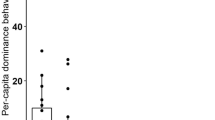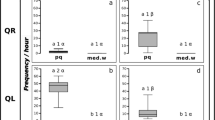Abstract
Ropalidia cyathiformis is a primitively eusocial tropical paper wasp usually with a single dominant queen per colony. When the queen is removed, one and only one individual increases her aggression and becomes the new queen of the colony, unchallenged by any other worker. We refer to such a successor as a potential queen (PQ) until she lays her first egg. By removing the queen and successive PQs, we show that there is not just one successor but a strict reproductive hierarchy of up to 3 PQs, who succeed the queen one after the other. Of many variables tested, we found that only the frequency of dominance behaviour is a significant predictor of whether or not an individual is part of the reproductive hierarchy and also of her position in the hierarchy. Dominance behaviour, however, does not perfectly predict the position of an individual in the reproductive hierarchy because we show that an average of three more dominant individuals, are bypassed when an individual becomes the next queen or PQ. This is in contrast to the reproductive hierarchy in the conspecific Ropalidia marginata, where age rather than dominance behaviour is a predictor (though imperfect once again) of an individual’s position in the queue. Taken together, our results suggest that (a) these two sister species have evolved two rather different mechanisms of reproductive caste differentiation, (b) that neither of them strictly conform either to the so-called “temperate” or “tropical” patterns of queen succession seen in most other species studied so far.


Similar content being viewed by others
References
Bang A, Gadagkar R (2012) Reproductive queue without overt conflict in the primitively eusocial wasp Ropalidia marginata. Proc Natl Acad Sci USA 109:14494–14499. doi:10.1073/pnas.1212698109
Bhadra A, Mitra A, Deshpande SA et al (2010) Regulation of reproduction in the primitively eusocial wasp Ropalidia marginata: on the trail of the queen pheromone. J Chem Ecol 36:424–431
Bridge C, Field J (2007) Queuing for dominance: gerontocracy and queue-jumping in the hover wasp Liostenogaster flavolineata. Behav Ecol Sociobiol 61:1253–1259. doi:10.1007/s00265-007-0355-9
Chandrashekara K, Gadagkar R (1991) Behavioural castes, dominance and division of labour in a primitively eusocial wasp. Ethology 87:269–283. doi:10.1111/j.1439-0310.1991.tb00252.x
Cronin AL, Field J (2007) Social aggression in an age-dependent dominance hierarchy. Behaviour 144:753–765
de Wilde J, Beetsma J (1982) The physiology of caste development in social insects. Adv Insect Physiol 16:167–246
Deshpande SA, Sumana A, Surbeck M, Gadagkar R (2006) Wasp who would be queen: a comparative study of two primitively eusocial species. Curr Sci 91:332–336
Dew HE, Michener CD (1981) Division of labor among workers of Polistes metricus (Hymenoptera: Vespidae): laboratory foraging activities. Insectes Soc 28:87–101. doi:10.1007/BF02223625
Fletcher DJC, Ross KG (1985) Regulation of reproduction in eusocial hymenoptera. Annu Rev Entomol 30:319–343. doi:10.1146/annurev.en.30.010185.001535
Gadagkar R (2001) The Social Biology of Ropalidia marginata: toward understanding the evolution of eusociality. Harvard University Press, Cambridge
Gadagkar R, Joshi NV (1982) Behaviour of the Indian social wasp Ropalidia cyathiformis on a nest of separate combs (Hymenoptera: Vespidae). J Zool 198:27–37. doi:10.1111/j.1469-7998.1982.tb02058.x
Gadagkar R, Joshi NV (1983) Quantitative ethology of social wasps: time-activity budgets and caste differentiation in Ropalidia marginata (Lep.) (Hymenoptera: Vespidae). Anim Behav 31:26–31. doi:10.1016/S0003-3472(83)80170-5
Gadagkar R, Joshi NV (1984) Social organisation in the Indian wasp Ropalidia cyathiformis (Fab.) (Hymenoptera: Vespidae). Z Für Tierpsychol 64:15–32. doi:10.1111/j.1439-0310.1984.tb00350.x
Gadagkar R, Vinutha C, Shanubhogue A, Gore AP (1988) Pre-imaginal biasing of caste in a primitively eusocial insect. Proc R Soc Lond B Biol Sci 233:175–189. doi:10.1098/rspb.1988.0017
Giannotti E, Machado VLL (1997) Queen replacement in post-emergent colonies of the social wasp, Polistes lanio (hymenoptera, vespidae). Rev Bras Entomol 41:9–11
Green JP, Leadbeater E, Carruthers JM et al (2013) Clypeal patterning in the paper wasp Polistes dominulus: no evidence of adaptive value in the wild. Behav Ecol 24:623–633. doi:10.1093/beheco/ars226
Hughes CR, Strassmann JE (1988) Age is more important than size in determining dominance among workers in the primitively eusocial wasp, Polistes instabilis. Behaviour 107:1–14
Hughes CR, Beck MO, Strassmann JE (1987) Queen succession in the social wasp, Polistes annularis. Ethology 76:124–132. doi:10.1111/j.1439-0310.1987.tb00678.x
Jeanne RL (1972) Social biology of the neotropical wasp Mischocyttarus drewseni. Bull Mus Comp Zool 144:63–150
Kardile SP, Gadagkar R (2002) Docile sitters and active fighters in paper wasps: a tale of two queens. Naturwissenschaften 89:176–179. doi:10.1007/s00114-002-0306-2
Kardile SP, Gadagkar R (2005) Observations on the natural history and behaviour of the primitively eusocial wasp Ropalidia cyathiformis (Fab.) (Hymenoptera: Vespidae). J Bombay Nat Hist Soc 102:265–273
Keeping MG (1997) Social behavior and brood decline in reproductive-phase colonies of Belonogaster petiolata (Degeer) (Hymenoptera: Vespidae). J Insect Behav 10:265–278. doi:10.1007/BF02765559
Lamba S, Kazi YC, Deshpande S et al (2007) A possible novel function of dominance behaviour in queen-less colonies of the primitively eusocial wasp Ropalidia marginata. Behav Process 74:351–356. doi:10.1016/j.beproc.2006.12.003
Litte M (1979) Mischocyttarus flavitarsis in Arizona: social and nesting biology of a polistine wasp. Z Für Tierpsychol 50:282–312. doi:10.1111/j.1439-0310.1979.tb01033.x
Michener CD (1969) Comparative social behavior of bees. Annu Rev Entomol 14:299–342. doi:10.1146/annurev.en.14.010169.001503
Mitra A, Saha P, Chaoulideer ME et al (2011) Chemical communication in Ropalidia marginata: Dufour’s gland contains queen signal that is perceived across colonies and does not contain colony signal. J Insect Physiol 57:280–284
Miyano S (1986) Colony development, worker behavior and male production in orphan colonies of a Japanese paper wasp, Polistes chinensis antennalis Pérez (Hymenoptera: Vespidae). Res Popul Ecol 28:347–361
Morimoto R (1961) On the dominance order in the Polistes wasps. I. (Studies on the social Hymenoptera of Japan. XII). Sci Bull Fac Agric Kyushu Univ 18:339–351
Murakami ASN, Shima SN (2009) Queen replacement in Mischocyttarus (Monocyttarus) cassununga (Hymenoptera, Vespidae, Mischocyttarini): a particular case. Sociobiology 53:247–257
Naug D, Gadagkar R (1998) The role of age in temporal polyethism in a primitively eusocial wasp. Behav Ecol Sociobiol 42:37–47
O’Donnell S (1998) Reproductive caste determination in eusocial wasps (Hymenoptera: Vespidae). Annu Rev Entomol 43:323–346. doi:10.1146/annurev.ento.43.1.323
Pardi L (1948) Dominance order in Polistes wasps. Physiol Zool 21:1–13
Premnath S, Sinha A, Gadagkar R (1996) Dominance relationship in the establishment of reproductive division of labour in a primitively eusocial wasp (Ropalidia marginata). Behav Ecol Sociobiol 39:125–132. doi:10.1007/s002650050274
Shukla S, Pareek V, Gadagkar R (2014) Ovarian development in a primitively eusocial wasp: social interactions affect behaviorally dominant and subordinate wasps in opposite directions relative to solitary females. Behav Process 106:22–26. doi:10.1016/j.beproc.2014.04.003
Strassmann JE, Meyer DC (1983) Gerontocracy in the social wasp, Polistes exclamans. Anim Behav 31:431–438. doi:10.1016/S0003-3472(83)80063-3
Sumana A, Gadagkar R (2003) Ropalidia marginata—a primitively eusocial wasp society headed by non-dominant queens. Curr Sci 84:1464–1468
Suzuki T (2003) Queen replacement without gerontocracy in the paper wasp Parapolybia indica in temperate Japan. Ethol Ecol Evol 15:191–196. doi:10.1080/08927014.2003.9522683
Tindo M, Mony R, Dejean A (2002) Colony development and serial polygyny in the primitively eusocial wasp Belonogaster juncea juncea (Vespidae: Polistinae). J Insect Behav 15:243–252. doi:10.1023/A:1015489017927
Watson JAL, Okot-Kotber BM, Noirot C (1985) Caste differentiation in social insects. Elsevier, Amsterdam
West-Eberhard MJ (1969) The social biology of polistine wasps. Museum of Zoology, University of Michigan, Ann Arbor
West-Eberhard MJ (1978) Temporary queens in metapolybia wasps: nonreproductive helpers without altruism? Science 200:441–443. doi:10.1126/science.200.4340.441
Wilson EO (1971) The insect societies. Belknap Press of Harvard University Press, Cambridge
Yoshikawa K (1963) Introductory studies on the life economy of polistine wasps: ii. Superindividual stage: 2. Division of labor among workers. Jpn J Ecol 13:53–57
Zanette L, Field J (2009) Cues, concessions, and inheritance: dominance hierarchies in the paper wasp Polistes dominulus. Behav Ecol 20:773–780. doi:10.1093/beheco/arp060
Acknowledgements
This work was supported by grants (to RG) from the Department of Science and Technology (including DST-FIST program), Department of Biotechnology (including DBT-IISc Partnership Program), Council of Scientific and Industrial Research, and Ministry of Environment, Forests and Climate Change, Government of India. SU was supported by a Research Fellowship from the University Grants Commission. We thank Dr. Kavita Isvaran for advice on statistical analysis. We thank Nitika Sharma for assisting in observations for two nests. RG and SU co-designed the study, SU conducted the study and RG and SU co-wrote the paper.
Author information
Authors and Affiliations
Corresponding author
Rights and permissions
About this article
Cite this article
Unnikrishnan, S., Gadagkar, R. Dominance based reproductive queue in the primitively eusocial wasp, Ropalidia cyathiformis . Insect. Soc. 64, 495–503 (2017). https://doi.org/10.1007/s00040-017-0568-5
Received:
Revised:
Accepted:
Published:
Issue Date:
DOI: https://doi.org/10.1007/s00040-017-0568-5




